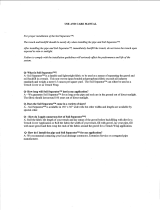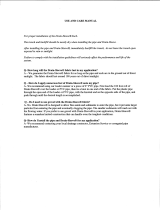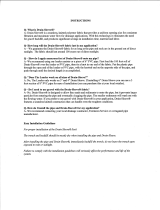
HEAT EXCHANGER CONDENSATE DRAIN AND VENT KIT
FOR R8HE / PPG3HE SERIES, GROUND MOUNT, CONDENSING STYLE GAS / ELECTRIC PACKAGE UNITS
SAFETY INFORMATION
IMPORTANT: Please read all instructions before
installing the kit. Pay attention to all safety warnings and
any other special notes highlighted in the manual. Safety
markings are used frequently throughout this manual to
designate a degree or level of seriousness and should not
be ignored. WARNING indicates a potentially hazardous
situation that if not avoided, could result in personal injury
or death. CAUTION indicates a potentially hazardous
situation that if not avoided, may result in minor or moderate
injury or property damage.
WARNING:
ELECTRICAL SHOCK, FIRE OR
EXPLOSION HAZARD
Failure to follow safety warnings exactly could
result in serious injury or property damage.
Improper servicing could result in dangerous
operation, serious injury, death or property
damage.
to the equipment.
to disconnecting. Reconnect wires correctly.
The installer performing this work assumes all responsibility
when installing this kit. These instructions are primarily
intended to assist qualified individuals experienced in the
proper installation of these components. Some local codes
require licensed installation/service personnel for this type
of equipment. Safety should always be the deciding factor
when installing this product and using common sense
plays an important role as well. Improper installation of
the components or failure to follow safety warnings could
result in serious injury, death, or property damage. After
completing the installation, return these instructions to the
Homeowner’s Package for owner-user’s future reference.
This accessory kit is for use with 2-5 Ton 95% condensing
style package gas/electric unit ground mount installations
for proper heat exchanger condensate disposal and
venting. Table 1 is a detailed listing of the components
in the Heat Exchanger Condensate Drain and Vent Kit.
Please check the contents of the kit with that of the parts
listing, and familiarize yourself with each component.
INSTALLATION INSTRUCTIONS
Table 1. Parts List
KIT SUPPLIED PARTS
ITEM # DESCRIPTION QTY
1
2” PVC x 90 Degree elbow & 1/4” Mesh sCreen 1
2
2” PVC x 10” PiPe 1
3 2” PVC Tee 1
4 2” x 1/2” PVC reDuCer bushing 1
5 1/2” barb x 1/2” nPTF 1
6 sPring hose ClaMP 1
7 1/2” iD x 36” Drain hose 1
8 horizonTal VenT suPPorT braCkeT & u-bolT 1
9 1/4-20 nuTs 4
selF Drilling sCrews (noT shown) 2
wire Tie (noT shown) 1
3 FT. Flexible insulaTion (noT shown) 1
FIELD SUPPLIED PARTS
• 2”PVCpipexLength.(Lengthisapproximately16”
+RegionalFrostLineDepthforunitonstandard
2’ concrete pad). NOTE: For a trench style drain
installation(page3)youwillalsoneed4”x36”(min.)
corrugated exible pipe w/ drain holes, a 2”x4”
PVC reducer, 4” corrugated piping connection,
2”x90degree.PVCelbow,and4”ltrationsleeve
or permeable barrier material.
• 40-80Lb. Rockorchat,(Limestonerock or lime
pellets if required by local code for neutralizing the
condensate when disposing into the ground).
• PVCSolventCleanerandPipeCement.
2
1
3
4
5
6
7
8
9

2
NOTE TO INSTALLER
drain line assembly, you may need to call to find out
where underground electric, gas, or other utilities
are located. Some state laws require that a locate
request be placed at least three (3) working days
prior to any digging projects. The utilities should
respond to your request by marking the approximate
location of their utilities or notifying you that they
have no utilities in your dig site area. After confirming
utility response, you can then proceed with your
excavation avoiding damages.
Table 2. Condensate Disposal Rate
FURNACE HX SIZE
UNIT CONDENSATE DISPOSAL RATE
STEADY STATE
3Tube–60KBTU 0.35 gPh
4Tube–80KBTU 0.45 gPh
5Tube–100KBTU 0.55 gPh
IMPORTANT NOTE: The flue condensate of this unit
is slightly acidic and some local codes may require
a neutralizing treatment when disposing directly into
the ground. Check state or local code requirements
for application of this equipment and if necessary
substitute limestone rock, chat, or lime pellets to
the pit to neutralize the condensate instead of using
basic rock or chat.
Preparing the pit
After pit location has been determined, the condensate
drain pit must be prepared for installation of the vertical
2”PVCventpipeandinsulateddrainhoseassembly.If
desired, remove any sod and top soil prior to digging for
later use at end of installation.
Verticalpitshouldbeapproximately12”-14”indiameter
(orlarger)for installation of the rockbaseandvertical
piping system to allow for proper drainage with a depth of
4”-6”belowtheregionalfrostlineifpossible.SeeFigure1.
Percolation Test (Optional)
Asimplepercolationtest(notrequired)canbeperformed
to aide in determining if the diameter and depth for the pit
is suitable. It will allow you to simply observe how quickly
a known volume of water dissipates into the subsoil of a
drilled hole of known surface area. In general, sandy soil
will absorb more water than soil with a high concentration
of clay or where the water table is close to the surface.
1.Connectthehorizontal13.25”x2”PVCpipe(supplied
with the unit) to the inducer motor rubber coupler
andsecureusing3”hoseclampprovided. NOTE: A
horizontalpipelengthupto18”isapprovedifpitlocation
circumstances require it to be further from the unit and
pad. A new support bracket or adaptor piece will have
to be field created to ensure the vent assembly does
not rotate.
2.Clean&gluethe2”x½”reducerbushingintotheTee.
3.Installthe½”hoseconnectortothereducerbushing.
4.Placethe2”PVCTeeontotheendofthehorizontal
pipe. DO NOT CEMENT THE TEE ON AT THIS TIME.
Dropaplumblinefromthebottomofthe½”draintting
to the ground to locate the starting point of the pit or
trench.
1.UsingTable2,identifytheapproximatevolumeofwater
being produced for the equipment being installed.
2.Pouravolume(V)ofwaterlargeenoughintothehole
capable of measuring the height.
(V)=(X)xSteadystateDisposalRate.
Example:For5-Tube(100,000BTU),ifX=4then
watervolume(V)=4x0.55GPH=2.20Gallons.
3.Immediatelymeasurethewaterleveldepthatthestart
of the test (Y1Start) and then again after one hour
(Y2Final).
NOTE: The pit water level height change should be
greater than or equal to the disposal rate height change
or you may want to widen or deepen the hole if possible.
PitWaterLevelHeightChange=(Y1Start)-(Y2Final)
should be greater than or equal to Disposal Rate Height
Change=(Y1Start)/(X).
Vertical Drain Pipe Installation
1. After the pit has been dug out, pour the rock or chat
base to a level approximately 2” below the frost line.
Mixin50%ofthelimestonerock,chat,orlimepellets
(ifrequiredbycode)withtheinitialrockbase.
2. Measure the distance between the top of the rock base
andbottomof½”draintting.
3.Cut the eld supplied 2”PVC pipe to the measured
length.
4.Cutthedrainhoseandinsulationtothemeasuredlength
less 3” so the drain cannot become blocked.
5.Connect vinyl drain tube to the ½” barbed drain
connectionatbottomof2”PVCTeeandsecurewith
spring hose clamp.
6.Installexibleinsulationovertheentirelengthofdrain
tube and cut away any excess, then secure at the top
with wire tie provided.
7.Placethe2”PVCpipeintothepitandworkthedrain
hose assembly into the pipe until the entire length is
inside and the PVC pipe is vertical.
8.Glue or use two 1/2”long screws (eld supplied) to
securethe2”PVCTeetotheunithorizontalventpipe.
See Joint A in Figure 1. NOTE: Fastening the Tee to
the horizontal vent pipe with 1/2” screws will make
disassembly easier for future cleaning or inspection of
the drain / vent system.
9.While holding the 2” pipe completely vertical and
centered to the drain tee, slowly backfill the pit around
the outside of the pipe. NOTE:Usetheremainingrock
or chat until above the frost line then use remaining
backfill materials from the excavation area.
10.Continuetobacklltheholeuntil1”-2”abovegradelevel,
then grade away to keep rain water from collecting in
the pit area as the ground settles over time. Add any
remaining top soil & sod back to pit location if desired.
11.ProceedtoCompletingtheVentsectiononpage3.
VERTICAL DRAIN PIT METHOD

3
IMPORTANT NOTE: The flue condensate of this unit
is slightly acidic and some local codes may require
a neutralizing treatment when disposing directly into
the ground. Check state or local code requirements
for application of this equipment and if necessary
substitute limestone rock, chat, or lime pellets to
the pit to neutralize the condensate instead of using
basic rock or chat.
Preparing the Trench
Startthetrenchwherethe2”verticalpipecanbeinstalled
vertically into the trench and centered under the vent
tee.Thehorizontaltrenchshouldbeapproximately8”-
10”widex30”-36”longwithaminimumdepthof12”-14”
(ordeeper)whenpossibletoallowforproperdrainage
and minimize chance of freeze up. The trench shoud be
directed away from the unit and home with an approximate
1”/12”slope.Todetermineifthelengthandwidthforthe
trench is suitable, refer to the optional percolation test
section on page 2.
Horizontal Drain Pipe Installation
1.Afterthetrenchhasbeendugout,layina3”-4”rock
or chat base the full length of the trench with a slight
slopeof1/4”-1/2”/perfoot.Mixin50%ofthelimestone
rock,chat,orlimepellets(ifrequiredbycode)withthe
initial rock base.
2.Clean and cement the eldsupplied 2” x 90 degree
elbowand2”x4”reducerassemblytogether.
3.Measureandcutalengthof2”PVCthatextendsvertically
fromthebottomofthe¾”drainttingatthebottomof
theteetothe2”elbow/reducerassemblyrestingonthe
rock base as shown in Figure 2.
4.Cutthe3/4”vinyldrainhoseandexibleinsulationto
thesamelengthasthe2”verticalPVCpipe.
5. Secure the elbow/reducer assembly to one end of the
4”drainpipe.
6.Cutthe4”corrugatedexibledrainpipewithdrainholes
to a length extending to the end of the trench.
7.Connect vinyl drain tube to the ½” barbed drain
connectionatbottomof2”PVCTeeandsecurewith
spring hose clamp.
8.Installexibleinsulationovertheentirelengthofdrain
tube and cut away any excess, then secure at the top
with wire tie provided.
9.Cementthe2”PVCpipeintotheelbow/reducerassembly.
10.Workthedrainhoseassemblyintothepipeuntilthe
entire length is inside and the PVC pipe is vertical.
11.Glueorusetwo1/2”longscrews(eldsupplied)to
securethe2”PVCTeetotheunithorizontalventpipe.
See Joint A in Figure 2. NOTE: Fastening the Tee to
the horizontal vent pipe with 1/2”screws will make
disassembly easier for future cleaning or inspection
of the drain / vent system.
12.Priortobackllinginstallthe4”exiblepipeltration
sleeve over the drain pipe or lay the permeable barrier
material down over the length of pipe in the trench.
13.While holding the 2” pipe completely vertical and
centered to the drain tee, slowly backfill the trench
over the full length of the pipe. Use any remaining
rockorchatuntiltheentirelengthof4”drainpipeis
covered then use remaining backfill materials from the
excavation area.
14.Continuetobacklltheholeuntil1”-2”abovegrade
level and then grade away to keep rain water from
collecting in the trench area as the ground settles over
time. Add any remaining top soil and sod back to pit
location if needed.
COMPLETING THE VENT INSTALLATION
1. Mark a pencil line up from the centerline of the unit vent
exit hole for aligning and attaching the vent support
bracket.
2.Holding bracket on pencil line at desired height (for
securingtothe10”ventpipe),securethesupportbracket
to the unit with two self drilling screws provided in kit.
3.Carefullyinsertthe1/4”meshscreenintothe elbow
and make sure it is firmly in place.
4.Cementthe2”x90degreePVCelbow(oppositeend
with1/4”meshscreen)and10”pipetogether.
5.Cementormechanicallyfastentheassembly(with1/2”
long screws) into the top of the tee. Verify the outlet is
perpendiculartotheunit.SeeJointBinFigure1and
Figure 2.
NOTE: Fastening the 10” pipe to the Tee with 1/2”
screws will make disassembly easier for future cleaning
or inspection of the drain / vent system.
6.Installthe2-1/2”U-Bolttosupportbracketusingnuts
(providedinkit)tosecuretheventassemblytotheunit.
NOTE TO INSTALLER
condensate drain line assembly, you may need to
call to find out where underground electric, gas, or
other utilities are located. Some state laws require
that a locate request be placed at least three (3)
working days prior to any digging projects. The
utilities should respond to your request by marking
the approximate location of their utilities or notifying
you that they have no utilities in your dig site area.
After confirming utility response, you can then
proceed with your excavation avoiding damages.
HORIZONTAL DRAIN TRENCH METHOD
(ALTERNATE DRAIN CONSTRUCTION)
If the surrounding area does not allow the digging of
a pit due to rock, dense clay soil, etc., the drain may
be applied in a shallower horizontal trench as long as
regional conditions allow. This type of application is not
recommended for areas where temperatures are below
20
0
F for extended periods of time but is also dependent
on the final depth of the trench if the frost line cannot be
reached. The unit will operate longer and more frequently
during colder weather to help keep the trench from freezing.

7096700 (NEW)
FROST
LINE
3"
2" - 3"
ROCK BASE
BELOW 2” PVC PIPE
12" - 14"
OR GREATER
4" - 6" OR DEEPER
BACK
FILL
ROCK/DIRT
MIXTURE
ROCK BASE
GRADE LEVEL
GRADE LEVEL
2” PAD
OUTER 2” PVC PIPE
(FIELD SUPPIED)
DRAIN HOSE TO END
OF 2” PVC CLEARANCE
DRAIN HOSE
& INSULATION
JOINT A
JOINT B
JOINTS A & B CAN BE MECHANICALLY FASTENED
USING STANDARD 1/2” LONG SCREWS. THIS WILL
MAKE DISASSEMBLY EASIER FOR FUTURE CLEANING
OR INSPECTION OF THE VENT AND DRAIN SYSTEM.
Figure 1. Condensate Disposal Using A Vertical Drainage Pit
30" - 36"
OR GREATER
3"
3"
2" - 4"
4" PIPE
DRAIN
BACK FILL
ROCK
ROCK BASE (SEE NOTE)
GRADE LEVEL
2” PAD
GRADE LEVEL
NOTE: SLOPE 1” / 12” IF POSSIBLE FOR TRENCH AND 1/4” - 1/2” / 12” FOR 4” PIPE.
CLOSE OFF END OF 4” PIPE
WITH PLASTIC CAP, END OF
FILTRATION SLEEVE, OR
PERMEABLE BARRIER MATERIAL.
JOINT A
JOINT B
JOINTS A & B CAN BE MECHANICALLY FASTENED
USING STANDARD 1/2” LONG SCREWS. THIS WILL
MAKE DISASSEMBLY EASIER FOR FUTURE CLEANING
OR INSPECTION OF THE VENT AND DRAIN SYSTEM.
Figure 2. Condensate Disposal Using A Horizontal Drainage Trench
Specications&illustrationssubjecttochangewithoutnoticeorincurringobligations(05/15).
O’Fallon,MO,©NortekGlobalHVACLLC2015.AllRightsReserved.
/




